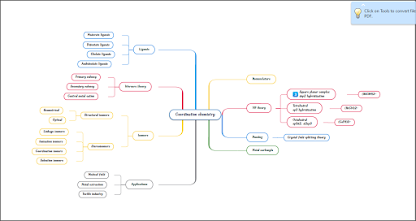COGNITIVE MAPPING
INTRODUCTION
Concept mapping is a great way to build
upon previous knowledge by connecting new information back to it. Concept maps
work very well for classes or content that have visual elements or in times
when it is important to see and understand relationships between different
things. They can also be used to analyze information and compare and contrast.
You create a concept map by writing key words (sometimes enclosed in shapes
such as circles, boxes, triangles, etc.) and then drawing arrows between the
ideas that are related. Then you add a short explanation by the arrow to
explain how the concepts are related. Concept maps may be used by instructional
designers, engineers, technical writers, and others to organize and structure
knowledge
Concept maps are used to stimulate the
generation of ideas, and are believed to aid creativity.[2] Concept mapping is
also sometimes used for brain-storming. Although they are often personalized
and idiosyncratic, concept maps can be used to communicate complex ideas.
Concept mapping was developed by Joseph D. Novak and his research team at
Cornell University in the 1970s as a means of representing the emerging science
knowledge of students.[8] It has subsequently been used as a way to increase
meaningful learning in the sciences and other subjects as well as to represent
the expert knowledge of individuals and teams in education, government and
business. Concept maps have their origin in the learning movement called
constructivism. In particular, constructivists hold that learners actively
construct knowledge.
BENEFITS OF
CONCEPT MAPPING
Concept maps are widely used in education
because
• It facilitates note taking and
summarizing gleaning key concepts, their relationships and hierarchy from
documents and source materials
• New knowledge creation: like
transforming tacit knowledge into an organizational resource, mapping team knowledge
• Collaborative knowledge modeling and
the transfer of expert knowledge
•
Facilitating the creation of shared vision and shared understanding within a
team or organization
• Instructional design: concept maps
used as Ausubelian “advance organizers” that provide an initial conceptual
frame for subsequent information and learning.
• Training: concept maps used as
Ausubelian “advanced organizers” to represent the training context and its
relationship to their jobs, to the organization’s strategic objectives, to
training goals.
•
Communicating complex ideas and arguments
• Enhancing metacognition (learning to
learn, and thinking about knowledge).
PREPARATION
Before preparing a cognitive map we
should be familiar with the unit and the concept related to it. We have to
prepare a single unit into a map format and thus, every small details of the
unit is important. There is main ideas, broad ideas and specific ideas in a
cognitive map. So the detailed analysis of the unit is appropriate before
preparing a cognitive map. A few open source mapping softwares are, Compendium,
Freeplane, Wisemapping, Xmind, CMAP, VUE, and FREEMIND. Other concept mapping
softwares includes, MindMeister, Ayoa, MindGenius, Milanote, Miro, Microsoft
Visio, SmartDraw, Lucidchart, Coggle and Visme.
I used mindomo app for concept mapping. Mindomo comes with many features to make your mind mapping journey as easy and pleasant as possible. My first cognitive map is from plus two chemistry text book, fourth unit " coordination chemistry". And the second cognitive map is from plus two chemistry text book tenthg unit “alcohol , phenol and ethers”.




Is cognitive map and concept map same?
ReplyDelete